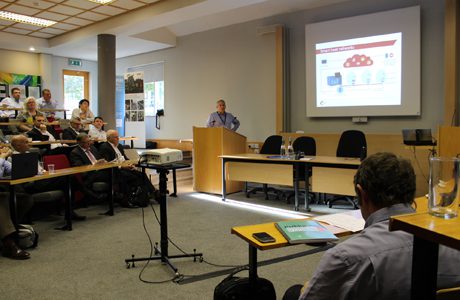
Industrial sized district heatpumps which draw warmth from the air, rivers, lakes, the sea and the ground are expected to play a key role in achieving COP21 carbon reduction targets because “they are the only proven, viable technology capable of delivering zero carbon heat in a large scale”, attendees at The Future of Thermal Energy Conference heard.
Hosted at Warwick University on 10-11 October 2016, the conference emphasised the importance of the UK government’s new focus on decarbonising heat.
Moving away from combustion technologies will help current policies get back on track to meet the UK’s carbon commitments. When you differentiate between technologies that save CO2 in the medium-term, such as gas CHP, and those that fully integrate with the grid’s natural decarbonisation progression, it becomes apparent that heat pumps are the only long-term and potentially zero carbon solution, it was suggested.
For Trevor Whittaker of Aqualor, who took installation and operational costs into account, heat pumps are also a financially sound solution. “Heat pumps have higher installation cost than a gas CHP but much lower operational costs at only 4% of capex and will last well beyond 20 years”.
Nicky Cowan, an engineer with Star Renewable Energy, said: “According to the Committee on Climate Change, heating may have to almost fully decarbonise if the UK is to hit its long-term goal of an 80% reduction in emissions by 5050”.
On top of this decarbonisation timeline, all new investment in heating will have to be zero carbon by 2035 in order to meet this target. For now, the Committee on Climate Change has already identified a gap of approximately 100 MtCO2e between the likely reductions from current plans and the reductions required by the fifth carbon budget. In recognising this shortfall, the government has committed to come up with an ‘emissions reduction plan’ to address decarbonising of heat, later this year.
Dave Pearson, Director of Star Renewable Energy, said: “Despite ignoring the cooling opportunities from large heatpumps and using quite pessimistic efficiencies, Government research shows the future heating demand will be mostly met by heat pumps.”
While admitting that the cheapness of gas and the higher taxation on renewable electricity didn’t produce favourable conditions for the flourishing of renewable heat, he said: “the RHI makes heat pumps a future-proof investment”. To date, universities and large estates such as airports have focussed on electrical decarbonisation largely ignoring heating and cooling. When government support for the RHI ceases in 2021 they will have to invest in the technology but with no financial support.
“The only barrier [to the uptake of renewable heat] is a likely strengthening of the grid but it isn’t as simple as some show it,” he said, referring to the models that examine high gas use vs much lower electrical supply. “Both lines on the chart have peaks and troughs, both have efficiencies not yet realised,” he said. “Whilst there might be local constraints overall the bottle neck is far ahead so we can right now take advantage of the decarbonised grid at 350g/kWh of CO2 equivalent, deploy heatpumps over 350% efficient and reduce emissions versus gas by over 50% – now!”.
Thomas Nowak, Secretary General of the European Heat Pump Association added that we know that heating and cooling are responsible for 50% of the energy demand in Europe, today. “We also know that heatpumps can efficiently provide both at the same time. So the only logical conclusion is that heatpumps have to be the central part of the decarbonisation of the system in order to realistically deliver COP21 carbon targets”.
Designed for business and large estates, as well as the energy and university sectors, The Future of Thermal Energy conference seemed to resound with a message about the importance of decarbonising heat and investing in low carbon renewable energy.







